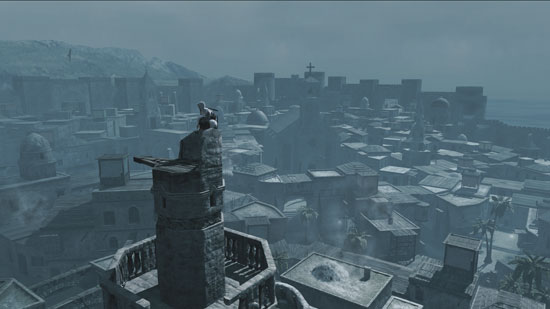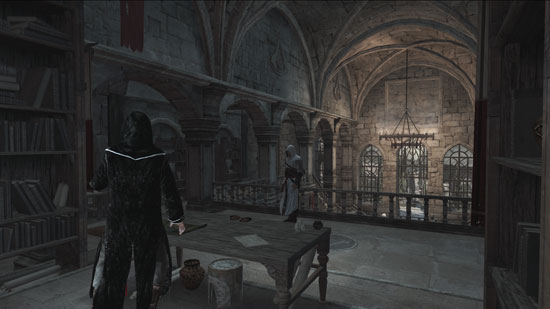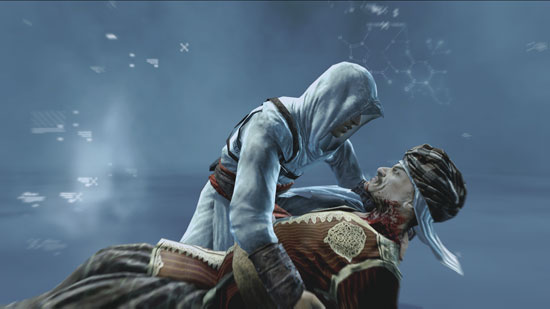More Gameplay
Side missions come in two varieties: information gathering related to your assassination target, and optional scouting/preparation. The latter consists of two tasks: climbing viewpoints and rescuing citizens. The easiest way to find side missions is to climb a viewpoint and scout out the area, after which you can perform a "Leap of Faith" into a conveniently placed pile of hay. While we seriously doubt the ability of anyone to fall over 100 feet (repeatedly) into a pile of hay without serious injury, the view from above can be quite breathtaking and the swan dive into the hay is graphically impressive. Rescuing citizens is a bit more mundane; you find a group of guards harassing someone and commence the slicing and dicing. Afterwards, the grateful citizen will offer to help you, either by spawning some vigilantes that will delay any guards pursuing you or by spawning a group of scholars that you can blend with in order to reach restricted areas without killing anyone.
 |
A third type of optional "mission" exists. Throughout the game, there are various flags scattered around the environment. You can try to collect all of these if you want to -- collect enough of them and you will gain another bubble on your "sync bar" (i.e. your health). Since you can have a maximum of 20 health points, however, there's no real reason to go out of your way to collect them all. On the Xbox 360 version of AC, collecting all of the various flags of a specific type will give you an Xbox Achievement; since there's no equivalent on the PC it seems the only reason to do this is for bragging rights.
The information gathering missions have a bit more variety. Some involve killing, some involve stealth, some are timed -- and some are a combination of any or all of those elements. There are nine different types of side missions, including four new mission types for the PC version of the game. Returning from the console are eavesdropping, pickpocketing, interrogation, guard assassination, and flag runs; new to the PC are roof races, archer assassination, escorting, and merchant stand destruction.
Archer and guard assassination missions are essentially the same thing, the only difference being that in the case of the former you assassinate archers on the rooftops and in the latter you assassinate guards patrolling the streets. These are both "stealth" missions, so you need to be careful that you don't attract attention -- if you ever get into an open battle during these missions, you will fail the mission and will need to try again. Later in the game, some of the stealth assassination missions will also have a time limit.
Eavesdropping, pickpocketing, and interrogation missions are also similar, in that you begin all three by listening in on a conversation. The difference is that for eavesdropping missions you have to find a nearby bench to sit on first, and on pickpocketing and interrogation missions you only need to stand nearby (but not too close). You also need to follow your target afterwards on these last two; on interrogation missions, you then beat up the person in order to "interrogate" them while on pickpocketing missions you will sneak up behind your target and filch whatever they are carrying.
The escort and merchant stand destruction missions generally involve outright conflict with the city guards. On the escort missions, you need to guide a fellow assassin to a "safe" location, killing any guards who try to stop you along the way. For the merchant stand destruction missions, you need to destroy anywhere between two and four merchant stands in a set amount of time; this is accomplished by throwing a nearby guard or other citizen into the stand. It may be possible to destroy merchant stands without triggering an encounter with the guards, but I was not successful in this attempt while playing the game -- and since the guards were easy enough to dispatch afterwards I didn't worry about it.
The final two mission types -- flag collection and roof races -- are timed missions. The roof races involve getting from point A to point B in a short amount of time, and this usually (but not always) requires sprinting across the rooftops. The flag collection missions also involve sprinting around an area in gathering a bunch of "misplaced" flags. Since I found the free running across roofs and climbing up buildings to be one of the most enjoyable aspects of the game, these last two were probably my favorite type of side mission. (There's plenty of killing to be had elsewhere.)
 |
All of these side missions are sort of filler as you progress through the game taking out the major assassination targets. The information gathering missions provide additional background details for the story, but the major plot points are all unveiled in the assassination mission assignments, the actual assassinations, and their aftermath. Each assassination mission is also unique, unlike all of the side quests that fade into each other, making them all the more enjoyable. First you have to infiltrate the stronghold of the target, then you typically get a cut scene of sorts showing you exactly why this person deserves to be killed, and then you have to figure out a good way to do your dirty deed and make good your escape. Sure, you can just wade in with your sword swinging (though you'll still have to watch the cut scene), but there's a certain satisfaction to be had by sneaking up on the target and performing a stealth kill.
 |
After each major assassination, you are presented with another cut scene that shows a dialogue between Altaïr and his victim. Like the "Leap of Faith", a certain suspension of disbelief is required as it's not uncommon for the person whose throat you just slit to go on rambling about his motivations for a good minute or two, but this is one area where the game takes a moment to flesh out the story.
All of the commentary on the previous two pages may give you some idea about what the gameplay is like, but it's probably just better if we show you some of the missions. We created videos of various missions during the second assassination target that are available for viewing at the end of this article. Note that these videos do contain some spoilers, and in particular the full 8 minute Garnier assassination sequence should be avoided if you want the story to remain a surprise. However, if you're not exactly sure whether you would like this style of game the videos should help answer that question.






















32 Comments
View All Comments
bill3 - Monday, June 2, 2008 - link
Actually it's terrible, I cant read the graphs AT ALL.seriously my eyes just glazed over those terrible charts..completely unreadable. I still, have no idea what I'm looking at. Is ATI supposed to be faster in this game? Why did they test with version 1.00 on ATI and 1.2 on Nvidia? I dont know because the graphs are totally useless.
Nihility - Monday, June 2, 2008 - link
I second that. The graphs are terrible. Maybe bar graphs would have been better?Sometimes when you're the one making the graph it's hard to imagine what other people are seeing when they look at them. I suggest having another pair of eyes check the graphs out for readability.
Besides that, I loved the review. Especially the performance part and the 10.1 controversy.
JarredWalton - Tuesday, June 3, 2008 - link
Charts are colored with similar colors used either for ATI vs. NVIDIA, 1.00 vs. 1.02, or dual-GPU vs. single-GPU. I could have generated four times as many graphs to show the same data, but I figure most people are capable of reading the labels on a chart and figuring out what they mean. Here's a hint: when you can't see the difference between two lines because they overlap, it's a tie.If you want to give specific examples and recommendations on what would look better and still convey the same amount of information, I'm all ears. However, simply stating that "the graphs are terrible" does little to help. Tell me what graph specifically is terrible, and tell me why it's terrible.
As an example of why I used these graphs, page 9 has two charts showing 40 total data points. You can get a clear idea of how performance scales with single or dual GPUs at the various detail settings looking at a single chart. Green is NVIDIA, Red is ATI. That makes a lot of sense to me. Creating ten different bar charts with four lines in each to show the same data makes it more difficult to compare how Medium graphics compares to High graphics performance, and it takes up five times as much space to tell the same "story".
Page 6 is the same thing, but with green used for dual-GPUs (light and dark for 1.00 and 1.02) and red for single GPUs. 24 data points in two charts instead of using six charts. Having established that 1.00 doesn't perform any different than 1.02 on NVIDIA hardware, I skipped the 1.00 NVIDIA numbers to make those charts easier to read on page 7. Then I put in the four standard test system (0xAA and 4xAA, ATI and NVIDIA) on 1.02, with 1.00 4xAA ATI in blue as a reference.
Lastly, on page 8 I have two clock speeds on NVIDIA, three on ATI, with different base colors for single and dual GPUs. ATI and NVIDIA are in separate charts, and brighter colors are for a higher overclock.
There's method to my graphing madness. Are the charts immediately clear to a casual glance? No, but then that's really difficult to do while still conveying all of the information. I spent a lot of time trying to make comprehensible charts, and settled on these as the best option I could come up with. Again, if they're so bad, it must be easy to generate something clearly better - have at it, and I'll be happy to use any sensible suggestions. However, if the only complaint is that you actually have to look at the charts and think for a minute before you understand, I'm not likely to be very sympathetic. I think our readers are smart enough to digest these graphs.
mpjesse - Monday, June 2, 2008 - link
While I appreciate the detailed review, isn't it a little irrelevant now? I mean, the game's been out for nearly 2 months now and it's been reviewed everywhere. The only thing new about this review are the performance benchmarks, in which case I would have have made the review solely about performance instead of gameplay.Just my 2 cents.
ImmortalZ - Monday, June 2, 2008 - link
Its sad that the companies with money always manage to suppress innovation.I hope this article by AT will raise some ruckus in the collective Interwebs and cause something. But I doubt it.
ViRGE - Monday, June 2, 2008 - link
For what it's worth, another forum I read had some screenshots comparing DX10 and DX10.1. The problems the poster had managed to find involved trees; there was some kind of post-processing rendering going on with trees that wasn't occurring with DX10.1, which made them look weird.Not fixing 10.1 may be an NVIDIA thing, but there was definitely a problem with it as-is.
tuteja1986 - Monday, June 2, 2008 - link
Well why where the hell is nvidia dx10.1 support if dx10.1 actually brings some kind of performance improvement in AA.Why aren't GT200 series have DX10.1 ?
I thought PC gaming was all about being the cutting edge on all technology front...
Anyways , this is not the 1st time Ubisoft or Nvidia have done this.
wyemarn - Monday, June 2, 2008 - link
Maybe because Nvidia GPUs cant support AA through shaders. So no use supporting dx 10.1. ATI GPUs have 320 stream processors so it can utilize for shaders and etc. Nvidia cards have less SPs but more ROPs, TMUs which translates to more brute power if games dont use shaders or SPs much. Technology wise, I think ATI is ahead but NVIDIA GPUs have game developer support and more raw horsepower so performance wise NVIDIA is ahead and I think this trend will continue with GTX200 series. I choosed G92 over RV670 because the raw performance is much better even though on paper HD 3800 series look great.SteelSix - Monday, June 2, 2008 - link
Worthy of a thread in Video. I just started one..Gannon - Monday, June 2, 2008 - link
The original halo had performance issues but they weren't alarming, halo was actually not too bad port compared to many other console to PC disasters. Halo 1 got 'better with hardware' advancing. Halo 2 on the other hand is just all around atrocious. Halo 2 was just not a very well made game, period, despite the addition of cutscenes, etc. Halo 1 had a much better feel and better vehicle design IMHO, I hated how the warthog looked in Halo 2, it annoyed me to no end.